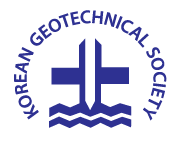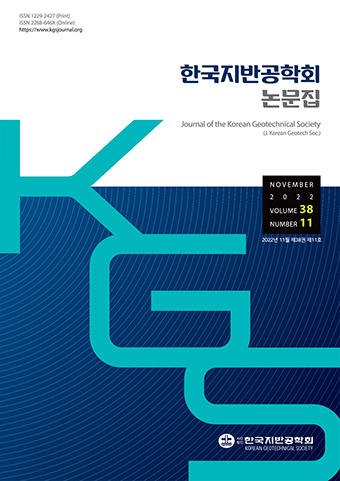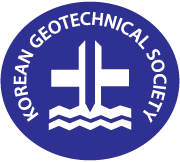Instructions for Authors
Publication type
In principal, manuscripts should be considered to be the original work and can’t be published in other registered Korean journals. What is more, when the author submits his or her manuscript, the author should clarify their manuscript as one of the three categories: Paper, Technical note, Discussion.
- Papers: Manuscripts should cover the geotechnical engineering field, have its own creativity, validity and the degree of completion and the manuscripts are recognized to be the academic and practical work.
- Technical notes: Manuscripts are not suitable to be published as a paper but contain recent technical advances, new research work, innovative ideas, and modifications and revisions to previously published papers.
- Discussions: Questions and answers regarding published papers and discussions.
To download a paper template, please go to the website: https://www.kgshome.org/59
Before the submission of manuscripts, the author should read through “the guidelines of writing a manuscript using paper template”, “the Author’s checklist”, “Instructions to authors and Ethical Guidelines” and prepare their manuscripts to be written accordingly. Once the author submits their manuscript, the editorial board considers the manuscript to be well-written accordingly.
If not, the editorial board can reject the submission of manuscripts and at any stage of the reviewing period, the manuscripts can be rejected for publication. To view the details of Ethical Guidelines, please go to the website: http://publicationethics.org/resources/flowcharts.
Submission fees
Two kinds of the Submission fees are as below.
Basic submission fee: 40,000 Korean won
Quick-review submission fee: 300,000 Korean won
Page charges for publication
Paper: 100,000 Korean won, if exceeding 10pages, 20,000 Korean won is charged per page
Technical note: 100,000 Korean won, if exceeding 8pages, 20,000 Korean won is charged per page
Ethical Guidelines
For the policies on the research and publication ethics not stated in this instructions, international standards for editors and authors (http://publicationethics.org/resources/international-standards-for-editors-and-authors) can be applied.
Address to submit, contact info on inquiry
Manuscripts should be submitted via the Article Contribution Management System (DBpiaONE): (https://dbpiaone.com/kgs/index.do). Any inquiries can be sent by an e-mail to the Editorial Office or the Editor-in- Chief, Research Fellow Jin-Tae Han, Department of Infrastructure Safety Research Korea Institute of Civil Engineering and Building Technology, Goyang Gyeonggi Korea (Tel.: +82-31-910-0259, Fax: +82-31-910-0561, e-mail: jimmyhan@kict.re.kr).
Peer review process
When manuscripts have been successfully submitted to one of 16 geotechnical areas, the Editor-in-Chief designates a responsible editor. The editor assigns two reviewers in a certain geotechnical engineering field to review the manuscripts.
After the paper review process, the Editor-in-Chief collects the reviewers’ overall opinions and makes a final decision. The decisions can be made as follows: Accept, Passed conditionally, Major revision, Reject. If one of the 2 reviewers rejects to publish the manuscript then a third reviewer continues to review the manuscript. The reviewing period is done within 4 weeks.
The manuscripts, rewritten by the reviewers’ comments, should be submitted within 3 months. If the author asks for an extension of revising his or her manuscript, another 3 months is granted. Upon the arrival of reviewers' comments, the author should submit the revised paper accordingly within 6 months. If not, the editorial board considers that the author has no intention of processing the paper to be accepted for publication; therefore, the editorial board officially can reject the paper for publication.
References
1. All numbered references in this manuscript must be cited in the text in English.
2. All the references in the text should follow the rules as below
a) When the text is referenced, the referenced part should have the parenthesis right beside and in the parenthesis, authors and publication year are provided such as Skempton(1948a) and Bishop(1956), (Yang, 1995; Hong, 1998).
Caspe(1966)는 벽체의 횡방향 변위로부터 지표 침하량을 산정하였다. 최근에는 현장 계측을 활용하여 지표침 하곡선을 구하는 방법도 제안되었다(양구승 1995; 홍길동 1998).
Skempton(1948a)과 Bishop(1956)은 비배수 ...
b) When the referenced materials in the text relate to more than 3 authors, the authors should be provided as (Kim et al., 1996; Jang, 2011).
황정순 등(2005)은 침하량 평가법으로 말뚝재료의 강성과 직경, 지반의 연직방향강성과 함께 지반의 횡방향 변형을 종합적으로 고려하도록 제안하였다. 박홍규와 김대영(2005)은 지중응력분포를 모델실험을 통해 각종 이론해와 비교분석한 바 있으며....
3. The order of how the references are cited is to be written in English in Alphabetical order and in case the referenced materials don’t provide English title and author’s name, the authors should translate the title and name into English right beside the Korean language title. The details of how the referenced material is presented are as below.
13. Kim, Y. S., Ko, H. W., Kim, J. H., and Lee, J. G. (2012), “Dynamic Deformation Characteristics of Joomunjin Standard Sand Using Cyclic Triaxial Test”, Journal of the Korean Geotechnical Society(KGS), Vol.28, No.3, pp.53-64. (in Korean)
4. The referenced materials by the same author should be written in order of the publication years and co-authors are followed by single authors in order.
5. If the number of authors exceeding 2 authors are punctuated with a comma in the references. The details of how the authors are referenced are as below.
4. Tavenas, F., Trak, B., and Leroueil, S. (1980), “Remarks on ...
6. All referenced materials must be cited in the order as below.
a) The journal of Korean Geotechnical Society : Number, Author(Publication year), “Paper Title”, The Journal’s title(italic type), Vol., No., Referenced page number.
12. 김달진 (1972), “아아칭 현상이 토압에 미치는 영향”, 대한토목학회지, 제20권, 제2호, pp.20-25.
13. Bishop, A. W. (1956), “The Strength of Soils as an Engineering Materials”, Geotechnique, Vol.16, No.2, pp.91-130.
b) Single Book : Number, Author(Publication year), The Journal’s title(italic type), Publishing Company, Printing place, Referenced page number.
7. 정인준, 김상규 (1990), 토질역학, 동명사, 서울, pp.89-95.
8. Terzaghi, K. (1943), Theoritical Soil Mechanics, John Wiley and Sons, New York, pp.100-120.
c) Report : Number, Author(Publication year), The Journal’s title(italic type), Report Number, Publication Number, Printing place, Referenced page number.
5. 토목설계공사 (1970), 한강댐 지질 조사보고서, 건설부, 서울, pp.25-30.
6. Kirby, C. R., and Lambe, T. W. (1972), Design of Embankment on Soft Soils, MIT Research Report R72-36, Soils Publication 307, pp.50-60.
d) Conference Proceedings : Number, Author(Publication year), “Paper Title”, Transaction Proceedings, Theme of the Conference(italic type), Complier, Publication Number, Conference venue, Referenced pager number.
4. Chan, S. F. (1993), “Behaviour of Foundations During Failure and Underpinning Using Micropiles”, Proc. of the 11th Southeast Asian Geotechnical Conference, Lee, S. L. ed., Singapore, pp.25-36.
e) Theses: Number, Author(Graduation year), “Paper Title”(italic type), Type of thesis, Accredited Institution, Referenced pager number.
2. 김병일 (1994), 선행재하공법 설계를 위한 전문가 시스템, 박사학위논문, 서울대학교, pp.55-60.
3. Gens, A. (1982), Stress-strain and Strength Characteristics of a Low Plasticity Clay, Ph.D. Thesis, University of London, pp.34-45.
* The title of the a) journals, b) books, c) reports, d) conference proceedings, thesis should be written in italic type.
7. Symbols(if needed): When symbols are needed, the description of the symbols should be clear and be placed in order described as above.
8. Technical note’s instructions
The same rules of the research paper are applied to the technical note and Technical note’s mark must be declared at the left top corner, the first page of the paper.


 Journal of the Korean Geotechnical Society
Journal of the Korean Geotechnical Society








